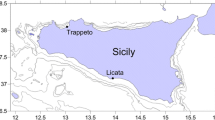Abstract
In fish, otoliths are continuously deposited elements with environmental information. This paper discusses the bioaccumulation level of essential and non-essential metals in water and otoliths samples of two threatened freshwater catfishes of genus Ompok collected from the Gomti river of Uttar Pradesh, India. The concentration level of trace metals (Ba, Sr, Zn, Mn) in otoliths and water samples differed considerably between sampling locations (p < 0.05) and a strong correlation exists on trace metals (r > 0.9) between otoliths and water samples. The occurrence of trace metal type and its concentration in otoliths proves the potential sites preferred for O. pabda and O. bimaculatus.
Similar content being viewed by others
References
Aguilera, O., and D.R. Aguilera. 2000. A new species of croaker Plagioscion (Perciformes, Sciaenidae) from the Orinoco River Basin, Venezuela. Memoria de la Fundación La Salle de Ciencias Naturales 60: 61–67.
Campana, S.E. 1999. Chemistry and composition of fish otoliths: pathways, mechanisms and applications. Marine Ecology Progress Series 188: 263–297.
Campana, S.E., G.A. Chouinard, J.M. Hanson, A. Frechet, and J. Brattey. 2000. Otolith elemental fingerprints as biological tracers of fish stocks. Fisheries Research 46: 343–357.
Campana, S.E., and J.A. Gagne. 1994. Cod stock discrimination using ICPMS elemental assays of otoliths. In New developments in fish otolith research, ed. D.H. Secor, J.M. Dean, and S.E. Campana, 671–691. Columbia: University of South Carolina Press.
Dorval, E., C.M. Jones, R. Hannigan, and J. Van Montfrans. 2007. Relating otolith chemistry to surface water chemistry in a coastal plain estuary. Canadian Journal of Fisheries and Aquatic Sciences 64: 1–14.
Farrell, J., and S.E. Campana. 1996. Regulation of calcium and strontium deposition on the otolith of Juvenile Tilapia, oreochromis niloticus. Camparative Biochemistry and Physiology 115(A): 103–109.
Hobbs, J.A., L.S. Lewis, N. Ikemiyagi, T. Sommer, and R.D. Baxter. 2010. The use of otolith strontium isotopes (87Sr/86Sr) to identify nursery habitat for a threatened estuarine fish. Environmental Biology of Fishes 89: 557–569.
Hunt, J.J. 1992. Morphological characteristics of otoliths for selected fish in the Northwest Atlantic. Journal of Northwest and Atlantic Fisheries Sciences 13: 63–75.
Kalish, J.M. 1989. Otolith microchemistry: Validation of the effects of physiology, age and environment on Otolith composition. Journal of Experimental Marine Biology and Ecology 132: 151–178.
Lakra, W.S., and U.K. Sarkar. 2006. Freshwater fish diversity of central India. India: National Bureau of Fish Genetic Resources-Lucknow.
Limburg, K.E. 2001. Through the gauntlet again: Demographic restructuring of American shad by migration. Ecology 82: 1583–1596.
Miller, J.A. 2009. The effects of temperature and water concentration on the otolith incorporation of barium and manganese in black rockfish Sebastes melanops. Journal of Fish Biology 75: 39–60.
Sarkar, U.K., B.K. Gupta, and W.S. Lakra. 2010. Biodiversity, ecohydrology, treat status and conservation priority of the freshwater fishes of river Gomti, a tributary of river Ganges (India). The Environmentalist 30(1): 3–17.
Secor, D.H. 1992. Application of otolith microchemistry analysis to investigate anadromy in Chesapeake Bay striped bass Morone saxatilis. Fisheries Bulletin 90: 798–806.
Singh, K.P., A. Malik, S. Sinha, V.K. Singh, and R.C. Murthy. 2005. Estimation of source of heavy metal contamination in sediments of Gomti river (India) using principal component analysis. Water Air Soil Pollution 166: 321–341.
Tsunagawa, T., T. Suzuki, and T. Arai. 2010. Otolith Sr: Ca ratios of freshwater goby Rhinogobius sp. to indicating absence of sea migrating traits. Ichthyological Research 57: 319–322.
Walther, B.D., and S.R. Thorrold. 2006. Water, not food, contributes the majority of strontium and barium deposited in the otoliths of a marine fish. Marine Ecology Progress Series 311: 125–130.
Westerman, R.L. 1990. Soil testing and plant analysis. Medison, WI: Soil science society of Amerika.
Zeigler, M.J., and G.W. Whiteledge. 2010. Assessment of otolith chemistry for identifying source environment of fishes in the lower Illinois River, Illinois. Hydrobiology 638: 109–119.
Zorica, B., G. Sinovcic, and K.V. Cikes. 2010. Preliminary data on the study of otolith morphology of five pelagic fish species from the Adriatic Sea (Croatia). Acta Adriatica 51(1): 89–96.
Acknowledgments
We express our sincere thanks to Dr W. S. Lakra, former Director, NBFGR and Dr J.K. Jena, Director, NBFGR, Lucknow, India for encouragement and proving necessary facilities. Thanks are also due to Uttar Pradesh Council of Science and Technology, Lucknow, Uttar Pradesh for partial financial support.
Author information
Authors and Affiliations
Corresponding author
Rights and permissions
About this article
Cite this article
Sarkar, U.K., Pathak, A.K., Gupta, B.K. et al. Habitat Fingerprinting Using Otolith Trace Metal Profile of Two Catfish Species of Genus Ompok (Siluridae) from Ganges Basin, India. Proc Zool Soc 69, 237–241 (2016). https://doi.org/10.1007/s12595-015-0144-9
Received:
Revised:
Accepted:
Published:
Issue Date:
DOI: https://doi.org/10.1007/s12595-015-0144-9




